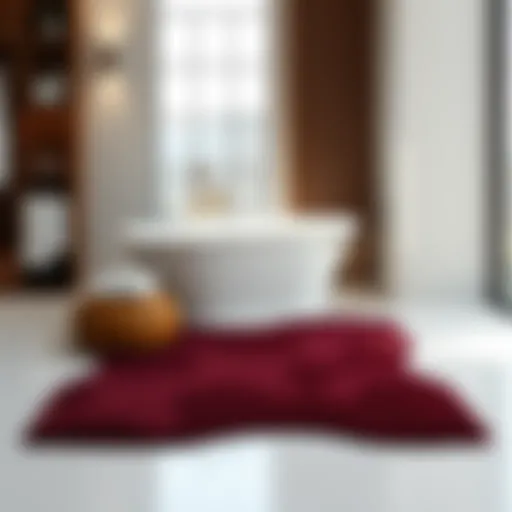Understanding the Importance of 24 Inch Planter Bowls
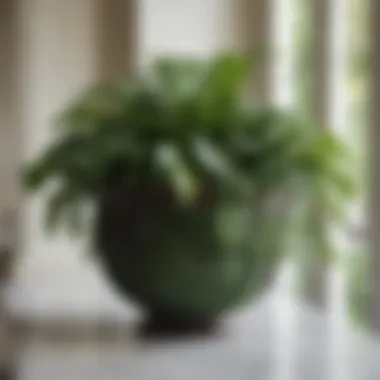

Intro
The world of home and garden design is constantly evolving, with trends coming and going like the seasons themselves. One might wonder, what really holds the charm in such a vast array of choices? Enter the 24-inch planter bowl. These versatile and spacious vessels have become a beloved staple among homeowners and designers alike. What makes them stand out in landscape design and interior decor?
First off, let’s talk about the size. A 24-inch planter bowl isn’t just for small flora; it's perfect for those lush plants that need room to breathe. They serve as anchors in garden beds or as focal points on patios. And whether you’re looking for a modern aesthetic or trying to capture a rustic feel, the right planter can become the cherry on top of your design cake.
Moreover, the material they're made from plays a crucial role. From ceramic to resin, each offers its own benefits and style, allowing for a great embrace of creativity. Curious how to maintain these beauties? We’ll dive into practical tips and suggest some plants that will thrive in these bowls without breaking a sweat.
By the end of this exploration, you'll have a clearer picture of how to effectively integrate 24-inch planter bowls into your individual spaces, all while marrying functionality with aesthetic appeal.
So, as we embark on this journey, prepare to unlock the potential that these planter bowls bring to a table that’s already so richly adorned with choices.
Intro to Inch Planter Bowls
When it comes to home and garden aesthetics, few elements can transform a space quite like 24-inch planter bowls. These versatile containers are not just vessels for plants; they play a crucial role in enhancing the overall look and feel of various environments, from cozy indoor corners to expansive outdoor patios. The importance of exploring these planter bowls cannot be overstated. They offer a unique blend of functionality and design, making them a staple in both residential and commercial settings.
Definition and Purpose
A 24-inch planter bowl is simply a round or oval container designed for holding plants, measuring about 24 inches in diameter. This size is large enough to accommodate a variety of plants, from shrubs to small trees, making them ideal for creating an impactful visual statement.
The purpose of these planter bowls extends beyond mere plant containment. They serve as focal points in landscaping, provide structure to garden beds, and enhance interior decor. In a way, they are like the frame of a beautiful painting, helping to define the space and guiding the viewer's eye. Their generous size allows for creative arrangements, letting homeowners express their personal style through plant choices and design.
Historical Context
The history of planter bowls has its roots in various cultures over centuries. Ancient civilizations, such as the Egyptians and Greeks, incorporated large pottery and stone containers filled with plants into their gardens. These early planters were often made from clay or stone and reflected the artistry of their time. Over the years, the evolution of materials and design philosophies has led to the modern 24-inch planter bowls we see today.
In the 18th and 19th centuries, during the Victorian era, gardens became a symbol of status and creativity. Larger planters, like the 24-inch bowls, were prominently displayed in estates and public gardens, symbolizing wealth and aesthetics. As we moved into the 20th century, with the rise of home gardening and urban living, these bowls became more accessible, allowing ordinary people to add beauty to their surroundings.
The 24-inch planter bowls remain relevant today as people seek to reconnect with nature, beautify their living spaces, and enhance their environments. Incorporating elements of history into modern design, these planters bridge the gap between the past and contemporary tastes, making them an integral part of landscaping and interior design.
Material Choices for Planter Bowls
Choosing the right material for 24-inch planter bowls is paramount, as it impacts not only aesthetic appeal but also functionality. The material affects how the planter interacts with the plant's needs, influencing growth, health, and even the overall design theme of the setting. Homeowners, designers, and garden enthusiasts must weigh options carefully, as each material brings its own set of characteristics, advantages, and challenges. This section expounds on three primary material choices for planter bowls: ceramic, plastic and resin, and metal.
Ceramic Planter Bowls
Characteristics
Ceramic planter bowls are renowned for their rich textures and vibrant colors. These pots are typically crafted from natural clay, undergoing a firing process to enhance durability. One of the distinguishing features of ceramic planters is their ability to promote a stable environment for roots. The porous surface allows for some breathability, which is beneficial to many types of plants.
This material choice is often favored for its classic look that adds elegance to any exterior or interior. Ceramic planters can also be glazed, which introduces uniqueness in terms of finish and pattern—making each piece feel special and artistic. However, their weight can deter some people from choosing them, especially in settings requiring mobility.
Pros and Cons
Ceramic planters come with their own sets of pros and cons. On the positive side, they provide excellent insulation for the roots, maintaining an even moisture level which minimizes the risk of overwatering. Additionally, many ceramic options are aesthetically pleasing, capable of serving as statement pieces in any landscaping or decor.
On the downside, the susceptibly of ceramic to chips and cracks is a concern. Especially in outdoor arrangements, a dropped ceramic bowl can break easily. Plus, the weight of ceramic planters can be an issue for those looking to switch positions or redecorate frequently. Hence, the choice of ceramic should be made considering both its beauty and potential drawbacks.
Plastic and Resin Options
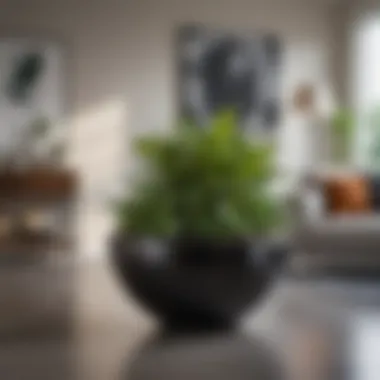

Lightweight Benefits
Lightweight benefits of plastic and resin planter bowls cater to a specific need nowadays—easy relocation and planting for those who may not have the strength to move heavier materials. These planters often weigh less than their ceramic counterparts, making them an appealing choice for gardeners who might want to switch up their arrangements frequently. Moreover, plastic affordability makes these planters accessible for many.
One notable feature is their resilience to weather elements. Unlike ceramic that may crack in harsh conditions, plastic and resin options withstand the rigors of both sun and snow without significant deterioration over time.
Variety of Designs
Another enticing aspect is the variety of designs available in plastic and resin planters. These materials can be molded into countless shapes and finishes, allowing for creativity in garden layouts. Whether someone prefers a modern, sleek look or something more rustic, there’s-bound to be an option available. This adaptability means that they can complement any design style or color scheme, providing a wide palette for gardeners to express themselves.
However, the challenge is that some cheaper plastic options may not possess the same visual elegance as ceramic, which may detract from their aesthetic appeal in more upscale settings. Homeowners need to balance quality and cost, ensuring that they select options that won’t easily fade or warp over time.
Metal Planter Bowls
Durability and Elegance
Metal planter bowls are the epitome of durability and elegance. This material radiates a sense of strength and sophistication, making it suitable for both indoor and outdoor use. Metal bowls, often made from aluminum or steel, can resist weather elements without losing their structural integrity. What sets them apart is their ability to become a focal point in any space—reflecting light and enhancing the surrounding greenery.
A unique feature of metal planters lies in their adaptability; they can be treated with various finishes, from painted to galvanized, catering to any modern, industrial, or even traditional landscape style known today.
Potential Disadvantages
Although metal planters offer numerous advantages, there are also potential disadvantages that are worth noting. One primary concern is their heat retention during peak summer months. In hot climates, metal can get scorching to the touch, which might negatively impact the soil temperature and, consequently, plant health.
Further, unlike ceramic or resin options that provide insulation, metal does not retain moisture as effectively, leading to quicker drying times. It's essential for users to be mindful of the watering needs of plants if they decide to go with this material.
Design Versatility of Inch Planter Bowls
The design versatility of 24-inch planter bowls plays a crucial role in how these planters are perceived and utilized across various environments—both indoors and outdoors. They can blend seamlessly into different themes and settings, making them highly sought after by homeowners, designers, and garden lovers alike. Their adaptability not only serves aesthetic purposes but also allows for practical applications in space enhancement. This section delves into the different design facets, emphasizing how these bowls can fit a personal style or meet the unique demands of a particular space.
Traditional Settings
Classic Appeal
The classic appeal of 24-inch planter bowls offers a timeless charm that enhances many traditional settings. These bowls, often made from materials like terracotta or ceramic, possess a quaint quality that adds warmth to gardens or outdoor patios. The rich colors and textures that come with these materials can create a feeling of nostalgia, inviting viewers to engage with the beauty of nature.
Many homeowners find their classic features beneficial, as they can easily enhance the overall aesthetic. A beautifully crafted ceramic bowl can serve as a focal point, drawing attention without overshadowing the surrounding décor. However, one key disadvantage is the weight of materials like ceramic, making them harder to reposition compared to lighter options.
Complementing Architecture
Complementing architecture is another significant aspect of utilizing 24-inch planter bowls in traditional designs. These planters can accentuate the existing structural elements of a home or garden. For instance, a bowl placed at a doorstep can soften harsh lines and edges, lending a sense of approachability and elegance.
The characteristic that stands out here is the range of historical styles found in planter design—from Colonial to Victorian. Each style informs the choice of bowl, allowing homeowners to match the planters with their architectural features effortlessly. A notable downside is that if they do not match in color or style, they can disrupt the intended visual harmony.
Contemporary Spaces
Sleek Aesthetics
When it comes to contemporary spaces, 24-inch planter bowls can provide sleek aesthetics that align perfectly with modern design principles. The clean lines and minimalistic forms found in these planters resonate with a focus on simplicity and functionality. They are often made from materials like resin or metal, which can contribute to a chic and polished look.
The key characteristic here is their ability to provide a fresh touch to any interior or exterior space. Sleek aesthetic designs can bridge both indoor and outdoor contexts, making them a popular choice. One drawback, however, could be their potentially cold appearance, which may not evoke the same warmth as more traditional materials. This may lead to a less inviting atmosphere if not balanced with softer elements like textiles or varied plant types.
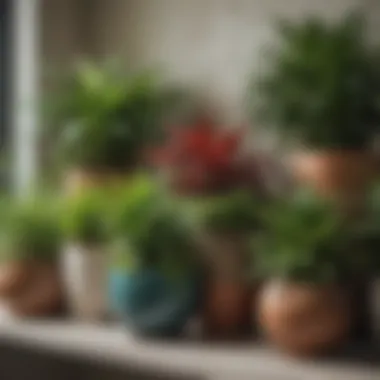

Merging with Modern Decor
Merging with modern decor is another way these planter bowls can enhance spaces designed for contemporary living. Whether it’s a chic urban apartment or a spacious loft, the right 24-inch planter bowl can integrate seamlessly into existing furnishings while adding a refreshing natural element. This integration speaks volumes about creating a holistic design approach.
However, the key characteristic of their versatility is their adaptability to various scenarios—stand-alone or as part of grouped installations. While this versatility is beneficial, some find it challenging to select plants that work well with modern styles, leading to potential mismatches in themes or vibes.
Outdoor Applications
Enhancing Garden Landscapes
In outdoor applications, the role of 24-inch planter bowls in enhancing garden landscapes cannot be overstated. Their strategic placement can define spaces, guide foot traffic, or create zones of color and interest throughout a garden. The rounded silhouette of these bowls can differentiate them from traditional square planters, offering a more organic approach to landscaping.
They can house a variety of plants, enriching the overall texture and layers of a garden. They can be a beneficial choice, especially in larger settings where the boldness of a 24-inch size can command attention without overwhelming the surroundings. However, one must consider maintenance since larger bowls may require more effort to care of, especially in terms of watering and drainage.
Functionality on Patios and Balconies
Finally, when discussing functionality on patios and balconies, 24-inch planter bowls open up myriad possibilities for small spaces. These planters can serve as makeshift dividers or provide necessary greenery in compact areas where traditional landscaping may not be feasible. Their size allows for a wide array of plants, creating eye-catching displays that can beautify any outdoor area.
A key benefit is the dual purpose of decor and functionality; they can hold flowers or herbs that enhance the space visually while providing fresh produce or fragrances. On the downside, depending on placement, they may obstruct movement if not arranged thoughtfully, so careful planning is essential for maximizing their potential.
Selecting Plants for Inch Planter Bowls
Choosing the right plants for 24 inch planter bowls is not just an afterthought, it’s a critical aspect of maximizing the visual impact and health of your greenspace. Understanding the plant's needs alongside the planter's capabilities ensures a harmonious relationship between flora and container. The flexibility provided by these bowls allows for creative expression, but it also comes with the responsibility of selecting plants that complement the environment. Whether you are a seasoned gardener or just dipping your toes into this vital part of horticulture, knowing what to grow in these spacious bowls can elevate the aesthetic of any space.
Consideration of Size and Growth Potential
The size of your planter bowl can limit or enhance plant choices based on the growth potential of individual species. A 24 inch bowl provides ample room, opening a door to a variety of plants ranging from short ground covers to tall statement plants. It is important to consider not only how big the plants will grow but also their spatial arrangement – crowding can lead to competition for nutrients and sunlight which won't be beneficial for anyone. A mix of sizes can create visual intrigue, but one must ensure that the larger plants don't overshadow the more delicate ones. Think of it as assembling a team; every member has to play their part without hijacking the spotlight.
Best Plant Types
Choosing the best types of plants can make all the difference. Each category of plants brings unique characteristics, so it’s crucial to assess which ones align with your goals for the planter bowl.
Flowering and Foliage Plants
Flowering and foliage plants undeniably brighten up planter bowls, lending a splash of color and vibrancy. They can transform a mundane entryway into a lively spectacle. The key characteristic of these plants is their ability to attract the eye – blooms can captivate onlookers and play a vital role in establishing a mood in outdoor or indoor environments.
For instance, vibrant petunias or geraniums can thrive in a bowl while harmonizing well with trailing ivy that adds a touch of elegance. One unique feature of flowering plants is their seasonal adjustment; with the right choices, you can have blooms at various seasons, continuous visual interest is just a thoughtful selection away. However, one disadvantage could be the need for more frequent maintenance like deadheading to promote continual blooming, which might not gel well with folks seeking a low-maintenance aesthetic.
Sustainable Options
Sustainable options are increasingly becoming a talked-about topic as more people turn their attention to eco-friendly gardening choices. Native and drought-resistant plants help in conserving water and are better adapted to local weather conditions. These plants typically require fewer inputs and can thrive on their own, making them an excellent choice for busy individuals.
The primary characteristic of sustainable options is their resilience. Their ability to flourish with little care makes them not only beneficial but incredibly practical, especially for those who might not have a green thumb. A unique feature of these plant choices is that they often support local wildlife since they contribute to the overall biodiversity of the area. That said, depending on the region, some sustainable plants might not have as dramatic visual appeal when pitted against their tropical counterparts, leading to a more subdued look.
In every choice, there lies a balance. Selecting plants involves weighing aesthetics, growth potential, and maintenance requirements to create a thriving environment in your 24 inch planter bowls.
Maintenance Considerations
Maintaining 24 inch planter bowls is crucial for their longevity and vitality. It's not just about keeping them clean; proper maintenance influences plant health and the overall aesthetic of your space. Regular care not only helps the plants thrive but also extends the life of the bowl itself. When you invest in planter bowls, understanding their maintenance needs ensures you get the most out of your greenery.
Watering and Drainage Systems
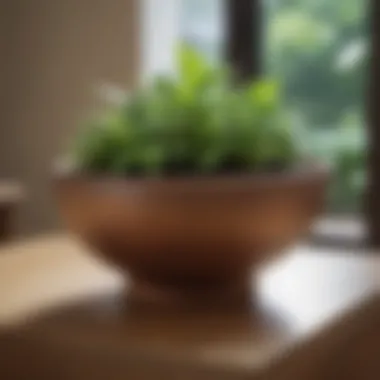

Watering is the lifeblood of plants, and for those in planter bowls, it’s even more critical. These bowls can retain water differently based on their material and design, which affects how often and how much they need to be watered. For example, ceramic bowls tend to hold moisture better than plastic ones. Here are a few essentials to consider:
- Watering frequency: It often varies with the season. During summer, more frequent watering might be necessary compared to winter. Keeping an eye on the topsoil can help indicate moisture levels.
- Drainage holes: Ensure your planter bowls have adequate drainage systems. Without proper drainage, excess water can sit at the bottom, leading to root rot. You can exploit the handy option of placing stones at the base to facilitate drainage.
- Monitoring moisture levels: A simple moisture meter can be a game-changer. It helps avoid overwatering or underwatering, both of which can stress your plants. Measure before watering, just to ensure the soil is ready for another drink.
Fertilization and Soil Quality
Soil quality is like the foundation of a house; if it’s poor, everything else falters. Using the right soil mix is essential for ensuring your plants have the nutrients they need to grow strong and healthy. Consider the following points:
- Choosing the right soil: A lightweight potting mix works well for these larger bowls, offering good drainage and aeration. Specialty blends are available for various plant types, so don’t hesitate to consult with a local nursery.
- Regular fertilization: Plants in planter bowls often need fertilizing to replenish nutrients leached out over time. Liquid fertilizers can be applied every few weeks during the growing season, while slow-release granules can work over several months.
- Soil testing: Occasionally, testing the soil pH and nutrient levels can provide insights into what your plants need. Many kits are available, enabling you to make informed adjustments to your care routine.
Seasonal Care Tips
As the seasons change, so do the needs of your plants. Seasonal care is vital to ensure that your 24 inch planter bowls thrive all year long:
- Spring preparation: As warmer weather approaches, it’s a good time to clean out any debris from the bowls. This is also a valuable juncture for replanting or refreshing your existing plants.
- Summer vigilance: During these warmer months, monitor moisture levels closely. Also, consider eyeing any pests that may find your plants attractive.
- Fall adjustments: As temperatures drop, moving sensitive plants indoors or to sheltered areas can protect them from frost. Reducing watering during this cooler weather can help prevent soil from becoming too moist.
- Winter care: Take care to position bowls where they won’t be covered in snow or ice, as prolonged exposure can damage the material. If keeping them outside, use frost-resistant designs to combat harsh conditions.
Maintaining 24 inch planter bowls isn’t a one-time effort. It’s an ongoing relationship, requiring attention, adjustments, and a willingness to learn.
By incorporating these maintenance considerations into your routine, you’ll find that your 24 inch planter bowls can flourish, adding vibrancy and beauty to your living space all year round.
Environmental Benefits of Using Planter Bowls
When it comes to enhancing our living spaces, the practicality of 24-inch planter bowls can’t be overstated. But beyond their aesthetic lure, these planters serve significant environmental purposes. They foster a more vibrant ecosystem and contribute positively to air quality, making them an essential addition for homeowners and designers alike.
Enhancing Air Quality
One of the foremost advantages of using planter bowls is their capability to improve air quality. Plants within these bowls, big or small, function as natural air purifiers. They can trap dust and release oxygen, thus contributing to a healthier atmosphere.
- Carbon Dioxide Absorption: Plants absorb carbon dioxide while releasing oxygen through photosynthesis. This exchange is not merely beneficial; it’s vital. With rising pollution levels in urban settings, incorporating plants into homes through planter bowls serves as a mini oasis for better air.
- Volatile Organic Compounds (VOCs): Many common indoor pollutants originate from household items like paint, cleaning products, and even furniture. Various houseplants, such as the Peace Lily and Spider Plant, have been shown to absorb these VOCs effectively. By placing these plants in 24-inch bowls, you increase their surface area and aesthetic presence while helping to detoxify the air.
- Humidity Control: Plants also play a role in regulating indoor humidity. Through a process called transpiration, they release moisture into the air, which can be particularly beneficial in dry climates or during winter when heating systems dry the air out.
"Plants are not just decoration; they are living contributors to our home's environment, enhancing comfort and health."
Biodiversity Support
Beyond individual home benefits, using planter bowls can significantly impact local biodiversity. Each small step towards a greener environment counts, and these planter bowls can foster diverse plant life.
- Habitat Creation: By incorporating various plants in bowls, homeowners can create small habitats that attract local wildlife such as birds, butterflies, and beneficial insects. By strategically choosing plants that bloom in different seasons, one can ensure that these critters have a year-round food source and shelter.
- Pollinator Support: Many flowering plants are crucial for pollinators like bees and butterflies. By using 24-inch planter bowls to house these plants, you can actively participate in providing food sources for these essential species. Plants like Lavender or Echinacea also attract pollinators, thus ensuring a thriving garden.
- Educational Tools: For families with young children, planter bowls can be educational. They provide a hands-on opportunity to teach kids about plant life cycles, the importance of biodiversity, and the need to protect our environment. By planting native species, families can learn about their local ecosystems and how to nurture them.
Considering the environmental benefits that come from these versatile bowls, it becomes clear that they do more than just beautify spaces. They hold the potential to play pivotal roles in enhancing air quality and supporting local biodiversity, which makes them all the more valuable in modern landscape design.
Ending
In wrapping up our exploration of 24-inch planter bowls, it’s pivotal to recognize the multifarious benefits they bring to both residential and commercial spaces. These planters aren’t just a vessel for soil and roots; they symbolize a unique blend of functionality and art. Whether you’re looking to accentuate a cozy nook or a sprawling patio, their role transcends mere decoration.
Summarizing the Importance
The importance of 24-inch planter bowls can be viewed through various lenses:
- Aesthetic Appeal: These planters contribute significantly to the decoration of a space. Their sculptural forms and diverse materials promote creativity in landscape design. Think about how a ceramic bowl with its glossy finish can reflect sunlight or a rustic metal planter can invoke a sense of vintage charm.
- Flexibility in Planting: Their size allows for a wide array of plant selections, from vibrant flowers to lush greenery. Homeowners can easily switch out plants according to the season or occasion. This flexibility provides room for personal expression and experimentation in gardening.
- Environmental Impact: Incorporating these bowls offers an opportunity to boost biodiversity. By choosing the right plants, they can function as mini-ecosystems that support local wildlife, including pollinators like bees and butterflies. Plants also improve air quality, providing a healthy atmosphere for occupants.
Final Thoughts on Integration
Integrating 24-inch planter bowls into your space isn’t just about setting a pot on the ground. It’s about carefully considering how they interact with their environment. Here are some considerations for effective integration:
- Positioning: Evaluate the light and weather conditions of your space. Ideally, choose spots that complement the natural characteristics of the plants you select. For example, sun-loving plants thrive on patios that receive ample direct sunlight.
- Design Cohesion: Whether your style is modern, traditional, or something in between, align your planter choice with your overall aesthetic. A sleek, minimalist white resin bowl could harmonize effortlessly with contemporary decor, while a textured terracotta option might complement a rustic interior beautifully.
- Seasonal Adaptability: Plan for changes in seasons. One can switch out plants or even the entire bowl' arrangement based on the season's mood, ensuring that the space feels dynamic and alive.
By understanding these key facets, homeowners, designers, and even DIY enthusiasts can truly appreciate and leverage the potential of 24-inch planter bowls. They are not merely decorative items; they are a canvas for creativity and sustainability.





